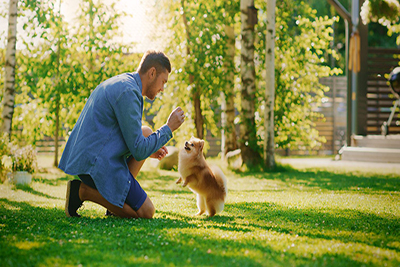Stopping your dog jumping up

Jumping up is a common behaviour in dogs, and if your dog is jumping all over you when you get home, or visitors coming over to your house, it can be both frustrating and embarrassing. Of course, your dog doesn’t realise what they’re doing, they’re just excited! So, they’re relying on you to teach them more appropriate ways to say hello.
Problems as puppies
Usually, dogs learn to jump up when they’re puppies. When your dog is small, jumping up can be a cute behaviour, and we give them praise and attention when they do it. But if your dog is fully grown and still jumping up on people, it’s not so cute anymore. In fact, some people can find it pretty intimidating.
Why does my dog jump up?
The first step in stopping your dog from jumping up is to understand why they’re doing it in the first place. Usually, dogs jump up as a way of getting attention, showing excitement and saying hello to people. We normally give attention to our dogs via our facial expressions, our voice and by patting them with our hands, so they’re just trying to get closer to our hands and our faces.
Ignoring the jumping up
A good way to begin teaching your dog that jumping up is not appropriate is to simply turn around the face away from them when they jump up on you. This is depriving them of what they’re seeking from you - attention. Wait for them to be standing on all four paws before you turn around again, then reward them with a pat or a treat. Remember, be consistent, and be sure everyone who comes into contact with your dog does the same thing.
‘Sit and stay’
If this isn’t working with your dog, you may need to teach them some alternative behaviours instead. Teaching your dog to ‘sit and stay’ is an effective way of showing them how to appropriately greet someone.
When you do any training, it’s ideal to start by practising in a quiet and familiar environment. Put your pup on a lead and stand a short distance away from them. When they jump up, say "no" firmly and guide them back down to the ground. Then, ask your dog to “sit and stay”, rewarding them with a treat and praise when they do.
Repeat this process several times, gradually building up to more challenging situations, such as when you come home from work or when meeting new people. It's important to be consistent and patient with your training, as it may take some time for your dog to understand.
Don’t reward bad behaviour
Another useful tip when stopping your dog from jumping up is to avoid inadvertently reinforcing the behaviour. This means not giving your dog attention or affection when they’re jumping up, as this can encourage them to keep doing it.
Instead, try to ignore your dog when they jump up and only give them attention or affection when they’re sitting or behaving calmly. Coming home each day is the perfect time to do this. Come inside, make a cup of tea, unpack the shopping… whatever you do, just remain oblivious to the attention-seeking behaviour of your dog. Wait for them to calm down, and then praise them and say hello. This can help to reinforce the idea that jumping up is not acceptable, and that they’re more likely to be rewarded if they remain calm and composed.
Another ideal time to test your training is when you’re about to take them for a walk. If you get the lead out and they start jumping up, simply put the lead away and wait for them to calm down before trying again.
With patience and consistency, your dog should eventually learn that the best way to say hello is on all fours.
